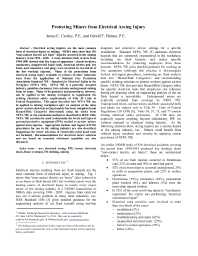Mining Publication: Protecting Miners from Electrical Arcing Injury
Original creation date: January 2007
Electrical arcing injuries are the most common form of electrical injury in mining. MSHA data show that 381 "non-contact electric arc burn" injuries occurred in the mining industry from 1996 - 2005. A more detailed study of data from 1990-2001 showed that five types of apparatus - circuit breakers, conductors, nonpowered hand tools, electrical meters and test leads, and connectors and plugs were involved in two-thirds of the lost workday injuries. Many of the protections from electrical arcing injury available to workers in other industries stem from the application of National Fire Protection Association Standard 70E - Standard for Electrical Safety in the Workplace (NFPA 70E). NFPA 70E is a generally accepted industry guideline document, but excludes underground mining from its scope. Many of its practices and procedures, however, can be applied in the mining workplace to supplement the existing electrical safety requirements of Title 30 Code of Federal Regulations. This paper describes how NFPA 70E can be applied to mining workplaces after an analysis of the mine power system electrical arcing hazards has been completed (and Hazard/Risk Categories determined) using the tables from NFPA 70E or the calculation method as described in IEEE 1584. NFPA 70E can then be used to determine the levels and types of personal protective equipment (PPE) needed to protect miners against burn injuries. Appropriate lockout and tagout (LOTO) procedures for use in the mining industry are also described. Suggestions for better selection of electrically-rated hand tools are included. Recommendations for electrical meter selection and use based on transient withstand capability are also discussed.
Authors: JC Cawley, GT Homce
Conference Paper - January 2007
NIOSHTIC2 Number: 20032718
IAS '07: Conference Record of the 2007 IEEE Industry Applications Conference: Forty-second IAS Annual Meeting, September 23-27, 2007, New Orleans, Louisiana. Piscataway, NJ: Institute of Electrical and Electronics Engineers, 2007; 4:1-8
See Also
- A Computer Software Program that Estimates Air Quantity Requirements in Large Opening Stone Mines
- Performance and Safety Investigation of Emergency Backup Batteries and Battery Charging Systems for Underground Mining Applications
- Practical Risk Assessment Guidelines for Identifying, Assessing, and Mitigating Stored Energy Hazards in Underground Coal Mines During and After a Mine Emergency
- Refuge Alternatives in Underground Coal Mines
- Safe and Economical Inerting of Sealed Mine Areas
- SPONCOM - A Computer Program for the Prediction of the Spontaneous Combustion Potential of an Underground Coal Mine
- Technology News 514 - The Air Quantity Estimator (AQE): A New Computer Software Tool for Large-opening Mine Ventilation Planning
- Technology News 545 - NIOSH Updates Spontaneous Combustion Assessment Software
- Ultra-Low Frequency Through-the-Earth Communication Technology
- Wireless Mesh Mine Communication System
- Page last reviewed: 9/21/2012
- Page last updated: 9/21/2012
- Content source: National Institute for Occupational Safety and Health, Mining Program


 ShareCompartir
ShareCompartir
